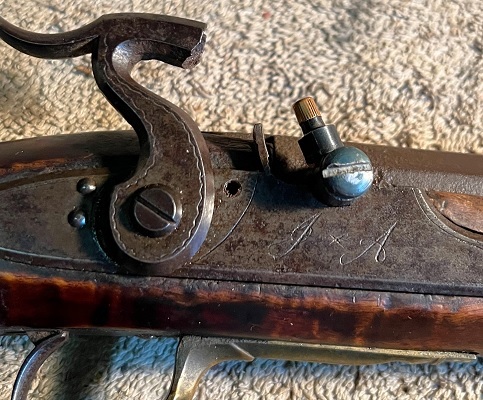 How the standard percussion system works: The copper cap contains a small amount of an impact-sensitive detonating compound. When the hammer strikes the cap, the compound detonates and the resulting flame is communicated to and ignites the powder charge. The gas pressure generated by the rapid combustion of the powder charge expells the projectile from the barrel. (Photo courtesy of Michael Hite).
How the standard percussion system works: The copper cap contains a small amount of an impact-sensitive detonating compound. When the hammer strikes the cap, the compound detonates and the resulting flame is communicated to and ignites the powder charge. The gas pressure generated by the rapid combustion of the powder charge expells the projectile from the barrel. (Photo courtesy of Michael Hite).
Introduction
I created this web page to organize 19th century information about the transition from flint to percussion cap ignition so I could better understand the long rifles produced in the Pennsylvania counties of Bedford and Somerset. As with any new technology, the adoption of the percussion cap occured at differing times and rates around the world. The materials included below help to illuminate the transition to percussion cap ignition in Great Britain and portions of the United States.
There have been competing claims as to who invented the percussion cap. This web page does not resolve that question, but it does provide insights about some of the contenders. In my opinion, the most likely inventor appears to be the early percussion cap maker Joshua Shaw.
L. Dietle, March 2023
1807-1821: Chapter II of the 1898 book "The Evolution of Modern Small Arms and Ammunition" provides a concise summary of the percussion ignition technology of Alexander Forsyth, Joseph Manton, and William Westley Richards that preceded Joshua Shaw's 1822 percussion gun patent.
Circa 1814: Report No. 1375 of the House of Representatives from the 53rd Congress (1893-1894) is titled "Heirs or Assigns of Joshua Shaw". The first page of the report states, "About the year 1814 Joshua Shaw invented the instrument known, and subsequently used thoughout the civilized world, as the patent diamond used by glaziers for cutting glass. About this time his attention was directed to the application and use of percussion or fulminating powders. He originated through chemical means and manipulations an entirely new material, free from the corrosive properties of those in use at the time. After repeated experiments he invented and introduced the percussion cap and lock for small arms, which in a short time, from its intrinsic value, was pretty generally adopted throughout the world and almost superseded the one previously used." Page 6 of the report states, "The first important question involved in this inquiry is, Was Joshua Shaw the original and bona fide inventor? To this we answer without hesitation that he was." That conclusion seems to rest on a quote from Henry Wilkinson's 1841 British book "Engines of War" regarding the invention of copper caps that states, "It becomes, therefore, an interesting inquiry to ascertain who really was the inventor. The late Mr. Joseph Egg, and several other persons, lay claim to it; but I have taken some pains to ascertain the truth, and, if in error, shall be obliged by better information upon this or any other subject. Mr. Egg, I believe, purchased it from Mr. Roantree, a gun-maker at Barnard Castle, Durham, who had it from a workman employed by Mr. Joshua Shaw, now residing at Philadelphia. I can trace it no further." A posthumous article about Joshua Shaw's life was published in the August 7, 1869 issue of the "Scientific American".
In a section about percussion arms in his 1841 book "Engines of War" (London) Henry Wilkinson also stated, "Mr. Shaw assured me that in 1814 he invented a steel cap, which, when fired, was retained to be primed again; that in 1815 he made a pewter cap, which was thrown away after using; and lastly, that in 1816 he used a copper cap precisely similar to those at present employed."
The Henry Wilkinson quote in House Report No. 1375 references Mr. Egg, who was a London gunmaker. The trade labels attached to the underside of the lid of some of Joseph Egg’s cased pistols included three groupings of words that, when considered together in sequence, read, ”By His Majesty’s Royal Letters Patent for the detonating self primer inventor of the copper cap.” The wording of the trade label seems to be claiming that by virtue of his patent for the detonating self primer, Joseph Egg was the inventor of the copper percussion cap. The only patent issued to Joseph Egg before Joshua Shaw's June 19, 1822 percussion gun patent that I know of was for an upside-down flintlock (British Patent No. 3676, March 30, 1813). Joseph Egg's November 26, 1822 Britsh patent no. 4727 is titled, "Certain improvements in the construction of guns and fire-arms, upon the self priming and detonating principle". Click here for an 1854 list of the British patents of William Westley Richards and members of the Egg, Manton, and Rowntree families (there are no Roantree patents listed).
1814: A September 15, 1827 letter from Joshua Shaw about testing gunpowder was published in Volume IV of "The Franklin Journal, and American Mechanics' Magazine". In the letter, Joshua Shaw states, "I constructed this apparatus in the year 1814; my principal object was to test the advantages afforded by using, with the percussion gun, the copper caps, or primers, which I had then invented."
Circa 1814 to 1829: The following image is a summary of the plaintiff Joshua Shaw's bill of exceptions in the patent infringement case of Shaw v. Cooper, 32 U.S. 292 (1833) at the U.S. Supreme Court. The summary indicates that the percussion cap system was already in use in England in 1819, and was in general use in England and France by 1821. Click here to read the case record as published in the 1901 book set titled "Cases Argued and Decided in the Supreme Court of the United States 1831-1834". (In the summary below, "1831" is a typographical error and should have been "1821".)

1818: In 1818, Collinson Hall won a silver medal for a percussion conversion of a flintlock firearm that incorporates a drum with a nipple and a mating hammer with a hollow nose that engages the nipple. Instead of a percussion cap, the illustration of the Hall invention shows the use of a pellet of detonating powder that "is fixed in the centre of a small round piece of paper covered with wax." and affixed to the hollow nose of the hammer. The medal was awarded by the Society for the Encouragement of Arts, Manufactures, and Commerce (London).
1818-1820: The "Percussion Caps" chapter of the 1909 book "The Rise and Progress of the British Explosives Industry" states, "On the 20th July, 1818, Prelat, a Paris gunmaker, patented a hollow cock and a conical nipple, which was charged by dropping a few grains of fulminate of mercury into the cavity of the cock. On the 28th July, 1820, he filed a certificate of addition, in which a flanged copper cap charged with a secret composition is substituted. A month later, Deboubert, also a Paris gunmaker, patented a cylindrical copper cap charged with fulminate of silver. Both these patents are believed to be merely copies or modifications of models made by the London gunmakers." The chapter also provides a wealth of other information about the history of the development of percussion ignition.
1819: An August 4, 1819 document from "Kingston, Upper Canada" is included as a chapter titled "Rifle Shooting, by an American Gentleman" in the 1841 book "The sportsman in France..." While not dispositive, a footnote on page 214 states, "The copper cap and nipple were not known in America when this paper was written." The only Kingston I know of in Canada is located about 56 miles north of Oswego, New York.
1820: The following excerpt from the March, 1905 issue of "Arms and Explosives" provides a transcript of a song that was sung on July 7, 1820. The song indicates that some form of the percussion cap was already known in Europe by 1820.

Circa 1820 to 1823: In a section titled "The Percussion Gun" in his 1823 British book "The Shooter's Companion" T.B. Johnson indicated he had used the copper cap plan for three seasons and found it superior in every point of view and concludes that, "Copper cap guns will unquestionably become general..." These remarks indicate that percussion cap guns had already been available in Great Britian for at least three years in 1823, but were not yet ubiquitous. The switch from flintlock to percussion was clearly underway.
1821: John James Audubon left at least two written accounts of encountering a percussion cap firearm during an 1821 visit at the home of an artist in New Orleans. In Chapter VII of an 1875 book edited by his widow that was titled "The Life of John James Audubon the Naturalist", Audubon stated, "...he prosecuted his work vigorously and afterwards asked me to examine a percussion lock on his gun, a novelty to me at the time. He snapped some caps..." A longer version of the story is included in a section titled "The Original Painter" in Volume II of John James Audubon's 1832 book "Ornithological Biography". In the story, Audubon stated, "So saying, the artist took up his palet, [sic] and was searching for a rest-stick; but not finding the one with which he usually supported his hand, he drew the rod of a gun, and was about to sit, when he suddenly threw down his implements on the table, and, taking the gun, walked to me and asked if 'I had ever seen a percussion-lock.' I had not, for that improvement was not yet in vogue. He not only explained the superiority of the lock in question, but undertook to prove that it was capable of acting effectually under water. The bell was rung, a flat basin of water was produced, the gun was charged with powder, and the lock fairly immersed. The report terrified the birds, causing them to beat against the gilded walls of their prisons." A section titled "Our Painters" in the December 1868 issue of "The Atlantic Monthly" indicates that the eccentric painter Audubon described was John Wesley Jarvis. According to entries in his journal Audubon "paid a visit to Jarvis" on January 9, 1821, then "walked to Jarvis the Painter and shewed him some of my Drawings" on January 13, 1821, and again "Went to Jarvis" on January 14, 1821. The January 13 and January 14 journal entries reference Jarvis's eccentricity. (Bill Paton made me aware of this Audubon percussion cap gun story by forwarding a copy of it from "Volume II" of the 1897 book "Audubon and His Journals" — a book that was edited by Audubon's grandaughter.)
1821: The February, 1905 issue of "Arms and Explosives" includes a September 13, 1821 letter which suggests an improvement to the type of percussion cap then in use.

1822: The immigrant Joshua Shaw's 1822 percussion firearm-related patent was lost in the 1836 fire at the United States Patent Office, and exactly what it described is a mystery. The following excerpt from the 1823 book "A list of patents granted by the United States..." references Shaw's patent:
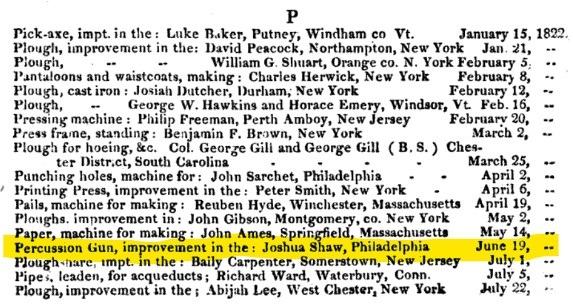
1822-1835: The following images are from the "List of patents" for "Class XIX — Fire arms and implements of war, and parts thereof..." in the 1847 book "List of patents for inventions and designs issued by the United States from 1790 to 1847..." The list shows that after Joshua Shaw's 1822 patent for a percussion system firearm, there was a flurry of new patents by other inventors for mechanisms related to percussion ignition.


1822: The following image is from the 1898 book "The evolution of modern small arms and ammunition". It illustrates the combined flint and percussion lock of the London gunlock maker Samson Davis's 1822 British patent no. 4648. Although Davis's invention was not a major step in the evolution of firearms, it does imply that the transition from flint to percussion cap ignition was underway in Great Britain in 1822.
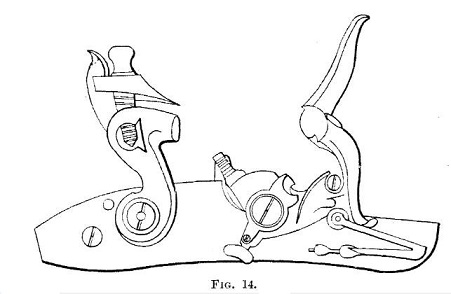
1823: The following synopsis of John Day's 1823 British patent no. 4861 is from the 1859 book "Abridgements of the specifications relating to fire-arms and other weapons, ammunition, and accoutrements." Day's 1823 reference to percussion caps demonstrates that percussion caps were then known in Great Britain.
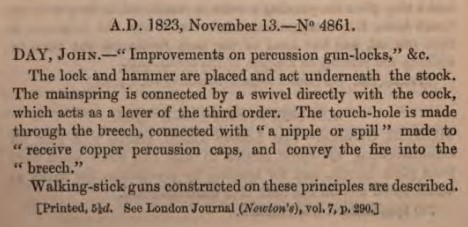
1823: According to Clay P. Bedford's article "The Forsyth Percussion System" in the "American Society of Arms Collectors Bulletin", Hereford resident E. Goode Wright wrote a September 18, 1823 letter to, and published in, "The Philosophical Magazine" that described the development of less corrosive copper caps that employed fulminate of mercury. According to Bedford, an 1829 letter Joshua Shaw sent to the "Franklin Journal" acknowledged the value of Wright's discovery.
1824: The following excerpt from the third edition of Hawker's book "Instructions to young sportsmen in all that relates to guns and shooting" (London: 1824) indicates that many people would consider the subject of flintlocks to be obsolete. The same statement is present in the 1826 and 1830 editions of the book.
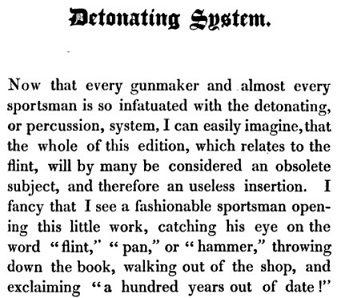
1824-1830: In a section titled "Anti-corrosive percussion powder" in the sixth edition of his book "Instructions to young sportsmen in all that relates to guns and shooting" (London: 1830) Hawker quotes a statement he wrote in August 1824 concerning a reduced corrosion percussion cap that was developed by a Soho chemist named Joyce. The section includes an 1830 post script that describes Mr. Joyce's successful commercialization of the invention.
1824: This is the earliest advertisement for percussion conversions that I have found. It is from the November 4, 1824 issue of the "Alexandria Gazette & Advertiser" newspaper:

1824: A report by a committee of the Franklin Institute about "Joshua Shaw's improved percussion primers" that was published in the November 20, 1824 issue of the "Mechanics' Magazine" includes the following statement: "These improved Primers are of two kinds; one is generally formed of copper... The first of these improvements, and which has been patented in the United States, is so generally known, that our observations upon it are almost superfluous; suffice it to say, that, as far as our knowledge of it goes, it has given almost universal satisfaction, and has been adopted by a great number of the most experienced shots in the country, who have uniformly recommended it to their friends, as a very valuable improvement, and perhaps the best extant at the time it was introduced; and its simplicity is such as to induce us to believe it is so nearly allied to perfection, that it will always divide the patronage of the public. Clearly, in 1824 the committee of the Franklin Institute believed that Shaw's 1822 patent covered percussion caps.
1825: The following excerpt from Volume II of the 1825 "New-York Mirror" reveals that percussion caps were then known in Brooklyn, New York:
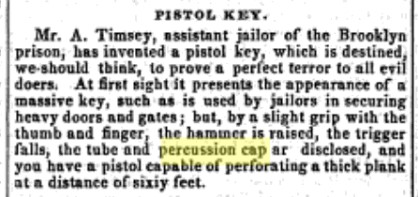
1825: In a section titled "On Gunnery" in the October 8, 1825 issue of the "American Mechanics' Magazine" (Broadway, New-York) William E. Wightman wrote the following about the advantages of percussion ignition:"The percussion lock has every advantage over the flint lock, namely, there is a less liability of accident by it, not being necessary to prime before loading, and the cock may be always kept on the cap except at the moment of firing, which prevents the gun going off at half cock; and if the gun is brought home loaded, by taking off the cap (which is the priming) there is no danger of its being fired by the foolishness of servants or others; and it is a fact, known to every observer of the percussion gun, that they kill at ten yards farther than a flint gun, and that about one quarter less powder is used for a charge, owing to the complete and instantaneous combustion of the whole charge of powder; and that there is no loss of force through the touch hole, as in flint guns; and also, that they receive the additional strength of the priming."
1826: In the following excerpt from the third edition of Hawker's book "Instructions to young sportsmen in all that relates to guns and shooting" (London: 1826), Hawker states, "...this is one of the reasons the percussion plan has so rapidly superseded the flint." The same statement is repeated in the 1830 edition.

1826: The availabilty of rifles with percussion ignition is mentioned on page 76 of the 1826 directory of Pittsburgh, Pennsylvania. In a straight line, the Point at Pittsburgh is about 58-miles northwest of the town of Somerset and about 85-miles west-northwest of the town of Bedford.


1826: In the following advertisement from the April 14, 1826 issue of the "Constitutional Whig" newspaper, James Tyrer offers percussion guns for sale, and indicates that he "is prepared to alter any guns into the Improved Percussion principle, so that they may be shot by percussion or by flint." Although Tyrer's June 3, 1825 patent was lost in the 1836 fire at the United States patent office, this advertisement informs us of the hybrid flint/percussion nature of his invention. As with Samson Davis's 1822 British patent no. 4648 referenced above, James Tyrer's hybrid flint/percussion invention might appeal to individuals who were worried about the reliability of the supply of those new-fangled percussion caps. Tyrer's patent implies that the transition from flint to percussion cap ignition was underway in Virginia in 1826.

1826: On page 161 of the 1826 Edinburgh, Scotland book "Manual of Chemistry" Andrew Fyfe indicated that the copper cap type of percussion system was then in common use, and provides a description of its advantages, compared to the older percussion systems that involved a priming reservoir.
1826: The following advertisement from the November 24, 1826 issue of the Boston newspaper "New England Farmer" includes the statement, "Will find at COPELAND'S POWDER STORE, 65 Broad Street, a complete assortment of Powder, Shott, Balls, Flints, and Percussion Caps."
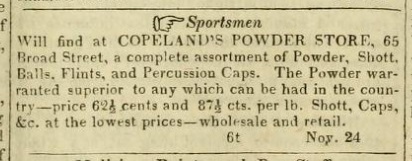
1827: The April 26 1827 issue of the "Martinsburg gazette and public advertiser" newspaper reprinted an article about a new percussion gun lock design that had been published in the "Yeoman's gazette" newspaper of Concord, Massachusetts.
1827: A chapter titled "The Lock" in the 1827 book "The American Shooter's Manual" includes the following statement: "The cap appears to be the most convenient method... There is one very serious inconvenience which we are subject to, in this country; in using the cap primer; and that is, the inequality of their size — this could, and ought to be remedied. We are in the habit of using the French, English, and American caps; all of which differ in shape and size, the first are more generally used, on account of their cheapness, though they are by no means so good, as either the English, or American. I have tried several kinds, and have never found any, that pleased me so well, as those made by Mr. Joshua Shaw, of Philadelphia; who by the by claims to be the original inventor."
1827: Each of the four pages of the "advertising section" in the rear of the 1827 book "The American Shooter's Manual" offer something related to percussion firearms for sale. G.W. Tryon's Gun Manufactory and Store offered "percussion powder and primers" for sale. William B. Scull offered "double and single percussion and flint fowling pieces; double and single do. ducking guns" (The abbreviation do. means ditto; i.e., percussion and flint.) John P. Moore's Military and Sportsman's Warehouse offered "Flint Guns and Pistols altered to the Percussion principle". Richard Constable's advertisment includes the headline "Percussion guns and primers". The body text of Constable's advertisement offered "an assortment of percussion guns of the finest quality, of his own and English makers — together with percussion primers" for sale.
1827: E. Copeland, Jr. ran two advertisements in the May 25, 1827 issue of the "New England Farmer" newspaper (Boston) that offered both flints and percussion caps for sale.
1827-1830: The December, 1830 issue of the "American Turf Register and Sporting Magazine" includes the following statement (apparently pertaining to a shotgun): "I have used a percussion gun for the four last seasons, and give it a decided preference over the flint; indeed I would not, for my own use, give a quarter of a dollar for the best flint gun that was ever made." That implies that he had been using a percussion shotgun since 1827.
1828: The reference to "20,000 percussion caps" in the following advertisement from the May 22, 1828 issue of the "Rhode-Island Republican" newspaper shows that percussion caps were then being mass-produced and were available in the United States in large quantities:

1828: The following advertisement from the December 3, 1828 issue of the "Daily Richmond-Whig" newspaper advertises percussion caps and both percussion and flint ignition pocket pistols.
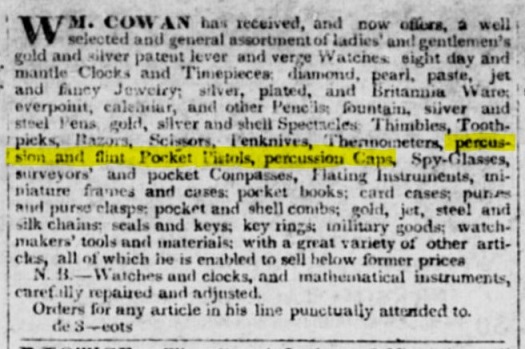
1829: Lowel Davies' advertisement in the March 23, 1829 issue of the "Lynchburg Virginian" newspaper offered percussion locks for sale. Lynchburg is about 179-miles from the town of Somerset, Pennsylvania and nearly due south.
1829: An article about making percussion powder that is reprinted in the March 27, 1829 issue of "American Farmer" (Baltimore) is preceded by a foreward that begins with the words, "As percussion guns are rapidly superseding those with the flint..." It also includes the statement, "It may be proper to remark here, that when the percussion lock is properly constructed, (and nearly all we have seen now for sale in the stores, and in use by gunsmiths, are of the proper construction) there is no danger whatever in firing them. Injury from the explosion of the caps can never occur with them; and those who have been injured, must have used locks of bad construction."
1829-1831: The following advertisement, which is dated August 4, 1829, was published in the March 17, 1831 issue of the "Phenix Gazette" newspaper for Joshua Shaw. It warns against importing, making, using, or selling unlicensed percussion firearms and percussion caps. The advertisement of Shaw's licensee George White was printed immediately below Joshua Shaw's advertisement.

1829: According to pages 124-125 in Volume IV of the "Journal of the Franklin Institute" (1829) Joshua Shaw's June 19, 1822 patent was "surrendered for the purpose of correcting the specification, and re-issued May 7."
1830: A January, 1830 letter from Fairfax County, Virginia that is reproduced in the March, 1830 issue of the "American Turf Register and Sporting Magazine" contains the statement, "Percussion guns are getting into general use, to the rejection of the flint, which is of itself, a proof of their superiority—when properly constructed they are not so dangerous (all guns are dangerous) as the cheap flint guns now imported. After a fair trial of both, I pronounce the percussion cap the greatest improvement made since the days of the match lock. They have been known here for many years, although not generally used till lately." This statement indicates that percussion guns were in general use in Fairfax County, Virginia by early 1830. That county is about 72 miles southeast of Bedford County, Pennsylvania. The letter also makes fun of a silly statement that someone had made in an earlier edition of the magazine.
1830: From statements on pages 25, 107, and 119 of his 1960 book "The Pennsylvania-Kentucky Rifle", it is clear that longrifle student Henry J. Kaufman believed that after circa 1830 percussion cap locks were being used on most newly made Pennsylvania long rifles.
1830: The 1984 book "Firearms of the American West, 1803-1865" quotes from a letter that Ramsay Crooks of the American Fur Company wrote to J. Joseph Henry of the Boulton Gun Works on March 30, 1830 about procuring rifles intended for service in a remote area. In the letter, Crooks objects to the use of percussion locks on the rifles, and states his preference for waterproof flintlocks.
1830: An advertisement for the "Music & Military Store" of William A. Ward in the September 1, 1830 issue of the Virginia "Wheeling Compiler" newspaper offers "Percussion Locks and Caps" for sale. In a straight line, Wheeling is about 86-miles west of the town of Somerset, Pennsylvania.
1830: The advertisement of R. Lane & Co. in the November 24, 1830 issue of the "Wheeling Compiler" newspaper offered "Percussion Locks, and Percussion Caps" for sale, along with roller-type flintlocks with waterproof pans.
1830: In a section titled "Copper Caps" in the sixth edition of his book "Instructions to young sportsmen in all that relates to guns and shooting" (London: 1830) Hawker stated, The copper cap is now in general use for detonaters..." Hawker also said he gave the copper cap concept to Joseph Manton although he (Hawker) was probably not the inventor, and "Thus Joe, who led the fashion for all the world, sent out a few copper-cap guns... The trade ... adopted this plan; and it proved to answer so well, that we now see it in general circulation." Hawker's claim of giving the percussion cap idea to Joseph Manton is not present in the 1824 or 1826 editions of the book.
1831: A January 27, 1831-dated advertisment by W.T. Compton in the February 17, 1831 issue of the "Martinsburg gazette and public advertiser" newspaper offers "Alexander Ready's superior Powder for Percussion locks" for sale.
1831: An auction notice by Otis, Dunlop & Co. in the April 5, 1831 issue of the "Constitutional Whig" newspaper of Richmond, Virginia lists "first rate fowling pieces, with percussion locks".
1831: The advertisement of R.D. Sanxay in the May 11, 1831 issue of the "Daily Richmond Whig" newspaper offers "pistols with flints and percussion locks" for sale.
1831: The 1835 book "Correspondence on the subject of the Emigration of Indians" contains 1831 War Department correspondence pertaining to supplying a significant number of rifles to the Choctaw and Senaca nations as stipulated by treaties. The rifles for the Choctaws were ordered from Philadelphia gunmakers in both flintlock and percussion. The Choctaws did not want the percussion rifles, and the percussion rifles were to be returned to the gunmakers so the lock mechanisms could be converted to flint ignition.
1831: An advertisement by the gunmaker Jacob Fordney that is dated June 23, 1831 includes the statement, "Guns altered to the percussion principle, and all other kinds of REPAIRING done in the best manner, and on the shortest notice." The advertisment was published in the "Columbia Spy" newspaper of Columbia, Pennsylvania. Columbia is about 106-miles due east of the town of Bedford, Pennsylvania.
1832: A large advertisement by David Kyle in the March 28, 1832, issue of the "Vandalia Whig and Illinois Intelligencer" newspaper offers "a choice selection of Rifles and Shot Guns, common and percussion locks" for sale. I interpret the common locks reference to mean flintlocks.
1832: A section titled "Percussion Locks" in Volume X of the 1832 book set "Encyclopedia Americana" (Philadelphia) describes the percussion technology and its advantantages over flintlocks, and then states, "Percussion locks have come very much into use..."
1832: Two advertisements in the July 28, 1832 issue of the "Spirit of the Times and Life in New-York" newspaper relate to the percussion system. An advertisement by Hinton's Warehouse & Manufactory offers flint and percussion rifles, percussion caps, and flints for sale, and also offers the service of "Flint locks percussioned". An advertisement by Lewis is titled "Percussion Caps" and "offers for sale The Improved Percussion Cap — the charges and construction of which is, on explosion, to prevent the caps from flying into fragments: thereby protecting the shooter from accident to the face, eyes, hands, &c." The Lewis advertisement is repeated in the September 1, 1832 issue.
1832: Volume 1 of the 1832 British book "Wild Sports of the West" indicates that guns using copper caps are "now in general use" and mentions the benefit of using percussion versus flintlock firearms in wet and stormy weather.
1832 to 1833: Calvin Hetrick's book "The Bedford County Rifle and its Makers" provides a transcript of some work-related items recorded in the account book of the Bedford County gunsmith William Border in the 1827 to 1847 timeframe. The earliest reference to performing a percussion conversion was on June 15, 1832, followed by conversions on June 18, 1832 and January 5, 1833.
1833: An advertisement by Howell Davies in the January 24, 1833 issue of the "Lynchburg Virginian" newspaper includes the statement, "Now opening on consignment, a large and beautiful assortment of single and double barrel Flint and Percussion Lock Guns, Pocket and Belt Pistols, with Flint and Percussion Locks".
1833: Joshua Shaw's percussion ignition patent was invalidated at the U.S. Supreme Court in 1833 (Shaw v. Cooper, 32 U.S. 292). As a result, anyone could import, make, use, or sell percussion firearms and percussion caps without fear of patent-related litigation. The ruling stated, "Whatever may be the intention of the inventor, if he suffers his invention to go into public use, through any means whatsoever, without an immediate assertion of his right, he is not entitled to a patent; nor will a patent, obtained under such circumstances, protect his right."
1833: The August 30, 1833 issue of the "Phenix Gazette" newspaper of Philadelphia reported on on a large scale French military trial of flintlock muskets versus percussion muskets, with each type firing 27,000 rounds. The failure rate of the percussion muskets was only 5% of the failure rate of the flintlock muskets (93 versus 1,826 failures). The article was also carried in the September 18, 1833 issue of the "Vandalia Whig and Illinois Intelligencer" newspaper.
1834: A notice in the February 15, 1834 issue of the "Alexandria Gazette" that was reprinted from the January 24, 1834 issue of the "Louisville Daily Journal" includes the statement, "I have lost a brace of Rifle Pistols with percussion locks".
1834: An article titled "Singular Circumstance" that was reprinted in the July 17, 1834 issue of the "Alexandria Gazette" newspaper describes some boys finding "a considerable number of razors, scissors, a quantity of pearl buttons, and fourteen percussion lock pistols" buried in the sand.
1834: A December, 1834 letter from Charleston that is reproduced in the January, 1835 issue of "The Southern Agriculturist" includes the statement, "Within a few years the flint and hammer lock has in a great measure yielded to the superior excellence of the percussion lock..."
1835-1855: In a section about percussion conversions of flintlock firearms, page 121 of Dillin's 1924 book "The Kentucky Rifle" states, "About 80% of all flintlock rifles and shotguns were changed to this percussion principle and were mostly done from the year 1835 to 1855." Although Dillin's book is a secondary source, he was a serious student of the history of Kentucky rifles.
1835: Howel Davies' advertisement in the April 2, 1835 issue of the "Lynchburg Virginian" newspaper offered for sale:
1835: In the following advertisement from the June 11, 1835 issue of the "New Hampshire Statesman and State Journal", the gunsmith James Eaton indicates that "He has on hand a general assortment of Gun Locks, Flint and Percussion..." and offers the service of "altering flint locks to percussion."

1835: In the first edition of his book "The Gun" (1835: London) Greener stated, "The use of flint-guns is now so nearly exploded, that it is scarcely worth the trouble to explain the principle of their construction." To Greener, at least, the question of flintlock vs. percussion ignition had been resolved.
1836: According to an article by Jim Whisker in the May, 2012 issue of the "Muzzle Blasts" magazine, the ledger of the Mestregat general store of Greensboro, Pennsylvania (Greene County) indicates that the gunsmith Barney Engle purchased percussion caps on May 6, 1836.
1836: Samuel Colt received his historic U.S. Patent 9430X for his "Revolving Gun" on February 25, 1836. The patent illustrates a percussion system firearm.
1839: The May 16, 1839 issue of the "Army and Navy Chronicle" reports on a trial of percussion versus flintlock muskets. The misfire rate of the percussion muskets was only 1.9% that of the flintlock muskets (17 versus 892 misfires). American officers were learning that percussion cap firearms were clearly superior to flintlock firearms.
1841: The 1841 book "Ordinance Manual for the Use of the Officers of the United States Army" has a section about the Model 1840 Hall's carbine that states, "This arm has a percussion lock." The section ends with a note that states, "Arrangements are in progress for adapting percussion locks to all small arms, agreeably to a decision of the War Department, made in February 1841." The flintlock was beginning to be replaced by the percussion lock in the United States military.
1841: The June 4, 1841 issue of "The Liberator" (Boston) includes the statement, "Percussion cap guns, instead of flint guns, have been introduced into the English army this year..." That statement may be based on a similar statement in the May 15, 1841 issue of "The Albion or British, Colonial, and Foreign Weekly Gazette" (New York).
1842: An article on page 74 of the February 12, 1842 issue of "The London Saturday Journal" mentions, "a detached company of our troops, armed with flint muskets, was surrounded by the enemy in great numbers, and unable to fire a shot in their defence, from their flint locks being rendered entirely useless by the rain. They were at length relieved by a party of their comrades, supplied with percussion arms. That settles the question of Flint versus Copper-cap."
1846: In a section about copper caps in the 1846 book "Modern Shooter" the author indicates that both Egg and Purdey believed they invented the percussion cap. Egg told the author that he made the first copper cap out of an old penny-piece. Purdey told the author that he made a brass cap that was shown around a few years before Egg came out with the copper cap. The author does not indicate that Purdey ever made more than one cap, and does not indicate that Purdey ever actually used the cap he made.
1846: Volume II of the 1846 British book "History of Inventions, Discoveries, and Origins" states, "The use of flint-locks to guns has, within the last few years, been almost entirely laid aside in this country; the percussion or detonating lock being substituted for it." The book indicates that the superiority of the percussion lock is attributable to the copper cap.
1855: Rollin White's April 3, 1855 patent (U.S. Patent No. 12,648), which is titled "Repeating Firearm", was the basis for the Smith and Wesson line of cartridge revolvers. Production of the "Model One" .22 rimfire revolver began in 1857. Although percussion muzzleloaders continued to be made, the breechloading metallic cartridge era was underway.
1860: Christopher Spencer received U.S. Patent 27,393 for his metallic cartridge lever-action repeating rifle design on March 6, 1860. According to the Library of Congress, over 200,000 Spencer rifles were produced in the 1860 to 1869 timeframe.
1860: According to his obituary in the November, 1860 issue of the "Historical Magazine" Joshua Shaw died on September 6, 1860.
1860: B. Tyler Henry's .44 caliber rimfire lever action rifle (U.S. Patent 30,446, October 16, 1860) was used during the U.S. Civil War, and was the forerunner of the Winchester line of lever action cartridge rifles.

See the firearm photos portion of the gunsmithing project for cap lock rifle examples